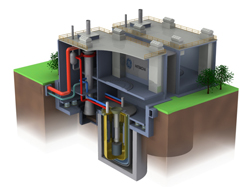
Are small modular reactors about to have their breakthrough?
 The Tennessee Valley Authority is commissioning Babcock & Wilcox, a nuclear equipment company, to design and apply for permission to build what would be the nation’s first small modular nuclear reactor in Oak Ridge, TN. This announcement has the potential to herald a new era for the U.S.’s nuclear industry. The concept of small modular reactors (SMRs) has been floating around for quite some time, but this is the first concrete step forward towards the Department of Energy’s (DOE) SMR Licensing Technical Support program’s goal of having a SMR ready for commercial use by 2022.
The Tennessee Valley Authority is commissioning Babcock & Wilcox, a nuclear equipment company, to design and apply for permission to build what would be the nation’s first small modular nuclear reactor in Oak Ridge, TN. This announcement has the potential to herald a new era for the U.S.’s nuclear industry. The concept of small modular reactors (SMRs) has been floating around for quite some time, but this is the first concrete step forward towards the Department of Energy’s (DOE) SMR Licensing Technical Support program’s goal of having a SMR ready for commercial use by 2022.
So, why is the looming prospect of SMRs big news? For that matter, what are they? ASP published an in-depth report , but in sum, a Small Modular Reactor is defined as a reactor that has a capacity of less than 300 megawatts. One third the size of conventional reactors, SMRs are one of the several designs that are contending to revolutionize the nuclear industry on a global scale.
Worldwide, there has been a growing interest in the development of more compact nuclear reactors. The cost and safety risks that come with large scale nuclear reactors don’t make for an attractive investment, especially in the United States. While global energy demands are expected to grow up to 80% by 2030, the United States seems to have reached a plateau. As the goliath reactors reach the end of their lifespan, gradually replacing them with smaller reactors is a potentially hopeful prospect for the industry.
SMRs would provide flexibility not possible with larger reactors. They can be added to a site incrementally, to replace or build up capability alongside other energy sources. They also can be used to provide a wider variety of energy needs such as district heating, industrial processes, and oil shale processes. Another benefit of this design is the decrease of safety risks. Their size would lessen risks of radiation due to their smaller core and also allows for the implementation of more passive safety measures. One popular vision surrounding this design is that production could become streamlined and the U.S. would potentially be able to export complete units, opening a whole realm of economic opportunity.
The main roadblock against SMRs is the fact they haven’t been tested yet. Therefore the questions about the actual safety and performance of the reactors go unanswered. Some of the concerns are the increased management that would be required to maintain several reactors, how to deal with nuclear waste coming from multiple sites, and whether or not they would really be as cost-effective as projected. The lack of concrete evidence for the potential benefits makes them risky investments that, up until now, companies have not gone forward with; which is why TVA’s concrete announcement commissioning a prototype is causing a stir. DOE’s goals are certainly long term, 2022 is still a ways off, but this may be the onset of a long awaited revolution in nuclear energy.





